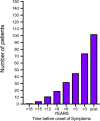Current concepts on Sjögren's syndrome - classification criteria and biomarkers
- PMID: 30178554
- PMCID: PMC6586012
- DOI: 10.1111/eos.12536
Current concepts on Sjögren's syndrome - classification criteria and biomarkers
Abstract
Sjögren's syndrome is a lymphoproliferative disease with autoimmune features characterized by mononuclear cell infiltration of exocrine glands, notably the lacrimal and salivary glands. These lymphoid infiltrations lead to dryness of the eyes (keratoconjunctivitis sicca), dryness of the mouth (xerostomia), and, frequently, dryness of other surfaces connected to exocrine glands. Sjögren's syndrome is associated with the production of autoantibodies because B-cell activation is a consistent immunoregulatory abnormality. The spectrum of the disease extends from an organ-specific autoimmune disorder to a systemic process and is also associated with an increased risk of B-cell lymphoma. Current treatments are mainly symptomatic. As a result of the diverse presentation of the syndrome, a major challenge remains to improve diagnosis and therapy. For this purpose an international set of classification criteria for primary Sjögren's syndrome has recently been developed and validated and seems well suited for enrolment in clinical trials. Salivary gland biopsies have been examined and histopathology standards have been developed, to be used in clinical trials and patient stratification. Finally, ultrasonography and saliva meet the need of non-invasive imaging and sampling methods for discovery and validation of disease biomarkers in Sjögren's syndrome.
Keywords: Sjögren's syndrome; biomarkers; classification; histopathology; ultrasonography.
© 2018 Eur J Oral Sci.
Conflict of interest statement
The authors declare that they have no conflict of interest.
Figures





References
-
- Sjögren H. Zur Kenntnis der Keratoconjunctivitis sicca. Acta Ophthalmol 1933; 11(Suppl): 1–151. - PubMed
-
- Greenspan JS, Daniels TE, Talal N, Sylvester RA. The histopathology of Sjögrens's syndrome in labial salivary gland biopsies. Oral Surg Oral Med Oral Pathol 1974; 37: 221–229. - PubMed
-
- Fisher BA, Jonsson R, Daniels T, Bombardieri M, Brown RM, Morgan P, Bombardieri S, Ng W‐F, Tzioufas AG, Vitali C, Shirlaw P, Haacke E, Costa S, Bootsma H, Devauchelle‐Pensec V, Radstake TR, Mariette X, Richards A, Stack R, Bowman SJ, Barone F. Standardisation of labial salivary gland histopathology in clinical trials in primary Sjögren's syndrome. Ann Rheum Dis 2017; 76: 1161–1168. - PMC - PubMed
-
- Shiboski CH, Shiboski SC, Seror R, Criswell LA, Labetoulle M, Lietman TM, Rasmussen A, Scofield H, Vitali C, Bowman SJ, Mariette X; International Sjögren's Syndrome Criteria Working Group . 2016 American College of Rheumatology/European League Against Rheumatism classification criteria for primary Sjögren's syndrome: A consensus and data‐driven methodology involving three international patient cohorts. Ann Rheum Dis 2017; 76: 9–16. - PubMed
Publication types
MeSH terms
Substances
LinkOut - more resources
Full Text Sources
Other Literature Sources
Medical
Research Materials

